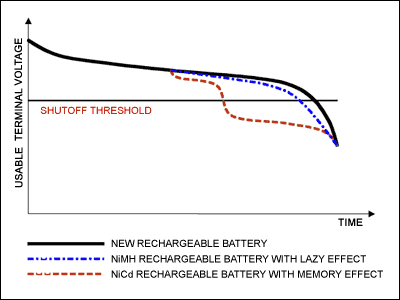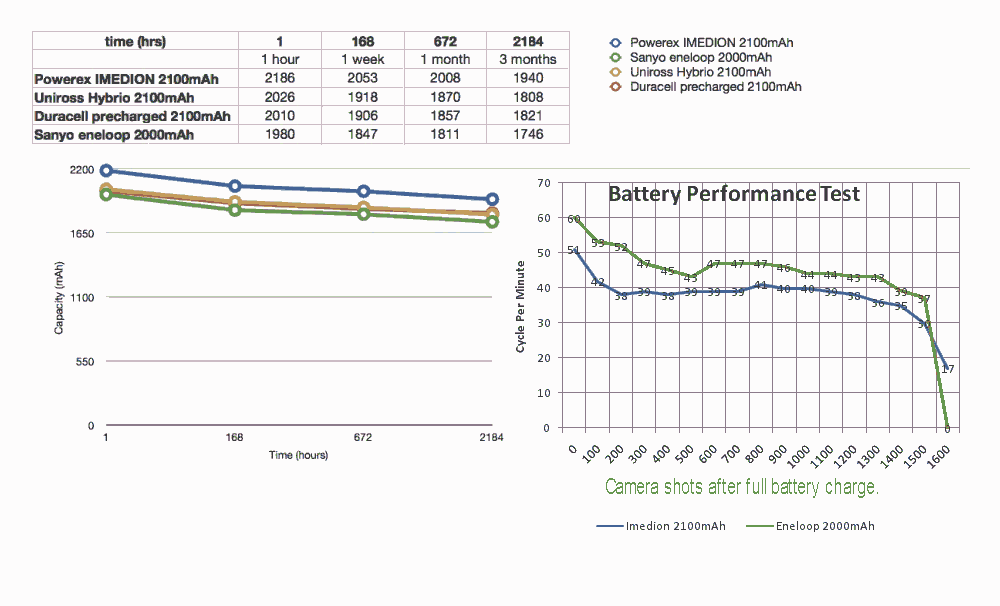Standard Dry Cell Rechargeable Batteries
There are several "dry cell" rechargeable battery types including nickel-cadmium (NiCd), nickel-zinc (NiZn), nickel metal hydride (NiMH) and lithium-ion (Li-ion). NiMH has replaced NiCd in most applications due to its higher capacity, but NiCd remains in use in power tools, two-way radios, and medical equipment. NiZn is a new technology that is not yet well established commercially.
Standard refers to standard consumer sizes, such as A, AA, AAA, C, D, and 9v square batteries.
A more disambiguous title, "Rechargable Dry Cell Batteries of Standard Consumer Sizes." These are mostly for portable electronics and other small consumer electrically powered products.
Contents
NiCad - Nickel-Cadmium battery
NiCad's are obsolete rechargeables. They've been replaced by NiMH's which last longer, don't suffer from the memory effect, and aren't toxic. NiCads have only one advantage over NiMH's, which is pretty minor: If you drain a NiCad down too far then a good charger can often resurrect it, but an NiMH drained too far will be more resistant to being brought back to life.
NiCad batteries can suffer from a memory effect. If you recharge a NiCad before it's mostly spent, the battery will "remember" the capacity at which you recharged it, so you will have reduced the capacity of the battery. The memory effect is only a problem if you repeatedly recharge a NiCad before draining it most of the way. Doing it once in a while doesn't necessarily impact battery life.
Both NiMH's and NiCads put out less voltage than alkaline batteries (1.2 V instead of 1.5 V).
NiCads don't last very long before needing a recharge. They typically have 50 to 67% less capacity than alkalines and NiMH's.
NiMH - Nickel Metal Hydride battery
These replace obsolete NiCad rechargeables. NiMH's have much higher capacity than NiCd's and don't suffer from memory effect. NiMH's are great all-around batteries but they have a high self-discharge rate (they go dead after a few months even if you don't use them) so they're not good for things like emergency flashlights or smoke detectors.
A nickel metal hydride battery, abbreviated NiMH, is a type of rechargeable battery similar to a nickel-cadmium (NiCd) battery but has a hydrogen-absorbing alloy for the anode instead of cadmium.
Because NiMH batteries, like NiCad, produce less voltage than disposable alkaline batteries, devices which require four or more batteries might not even work at all with NiCads or NiMH's.
You can't recharge NiMH batteries in an old NiCd charger or you risk battery explosion.
Nickel metal hydride batteries recharge fewer times than NiCad and they perform very poorly in cold temperatures.
Although NiMH batteries don't suffer from the memory effect that NiCd's have, they do have a less severe "lazy effect." The lazy effect is a weaker version of the memory effect. The lazy effect results from the crystallization of a portion of the nickel. Like the memory effect, the lazy effect prevents full use of the capacity in a rechargeable battery; both effects, however, can be avoided by using chargers with a discharge function.
Li-Ion - Lithium Ion battery
Lithium-ion batteries have a higher energy density than most other types of rechargeables. This means that for their size or weight they can store more energy than other rechargeable batteries. They also operate at higher voltages than other rechargeables, typically about 3.7 volts for lithium-ion vs. 1.2 volts for NiMH or NiCd. This means a single cell can often be used rather than multiple NiMH or NiCd cells.
Lithium-ion batteries also have a lower self discharge rate than other types of rechargeable batteries. This means that once they are charged they will retain their charge for a longer time than other types of rechargeable batteries. NiMH and NiCd batteries can lose anywhere from 1-5% of their charge per day, (depending on the storage temperature) even if they are not installed in a device. Lithium-ion batteries will retain most of their charge even after months of storage.
Lithium-ion batteries are more expensive than similar capacity NiMH or NiCd batteries. This is because they are much more complex to manufacture. Li-ion batteries actually include special circuitry to protect the battery from damage due to overcharging or undercharging.
Do not confuse Lithium batteries and Lithium Ion batteries. Lithium batteries are not rechargeable while Li-Ion are.
Lithium ion batteries are not available in standard cells sizes (AA, C and D) like NiMH and NiCd batteries. This may be due to safety reasons since a lithium-ion battery put into a NiCd or NiMH charger not designed for lithium-ion, might ignite. Also, because Li-ion batteries operate at much higher voltage (typically 3.7V per cell) than the 1.2 to 1.5V of most cell batteries, designing a 1.5V lithium-ion cell would be expensive.
Additional Information
Charging
NiCad and NiMH batteries are amongst the hardest batteries to charge. NiMH batteries can require anywhere from 3 to 6 or more full deep and slow charging cycles before reaching their peak capacity. Wheras with lithium ion and lead acid batteries you can control overcharge by just setting a maximum charge voltage, the nickel based batteries don't have a "float charge" voltage. So the charging is based on forcing current through the battery. The voltage do do this is not fixed in stone like it is for the other batteries.
The minus delta V bump that is indicative of end-of-charge is much less pronounced in NiMH than NiCad and depends on temperature. New NiMH batteries can exhibit bumps in the curve early in the cycle, particularly when cold. Also, NiMH are sensitive to damage on overcharge.
If you need or prefer using a fast NiMH battery charger, it is important to use a fast charger that has been designed to charge quickly without overcharging or causing excess heat.
ome cheap or poorly designed fast NiMH battery chargers will decrease the battery life by overcharging or generating excess heat. These are caused primarily by:
- Not detecting the “End of Charge”; and,
- Continuing to charge at a high rate.
- Some NiMH Batteries cannot handle high charge currents; and,
- When heat builds up, the NiMH Battery Charger fails to take appropriate action.
Technology Advances
New hybrid Ni-MH cells offer the convenience and shelf-life of alkalines, and the high-drain performance of older Ni-MH batteries.
Today, the best rechargeable batteries are the new hybrid Nickel-Metal Hydride (Ni-MH) cells. These hybrid batteries have a lot going for them: they come fully charged (like alkaline batteries), and they can hold their charge over may months (unlike regular Ni-MH rechargeables). Because they can hold their charge for so long, they are suitable for low-drain devices like remote controls and flashlights.
Brand Names
- Sanyo eneloop - Sanyo says Eneloops can be recharged up to 1000 times, and they will retain their charged capacity even after 6 or 12 months of storage. (According to Sanyo the specs are: 90% of charged capacity retained after 6 months, and 85% capacity after 12 months at 20 degree Celsius). The AA-sized (R6) batteries are rated at 2000 mAh, and the AAA-sized (R03) cells are rated at 800 mAh.
- Powerex Imedion - Pre-Charged and Ready-to-use Rechargeable Batteries retain up to 85% of charge after one year of storage.
- LaCrosse Technology BC-900 Alpha Battery Charger
- Maha PowerEx “Ultimate Professional” Charger
- Sanyo Eneloop Quick Charger - 2 AA batteries recharge in about 4 hrs.

